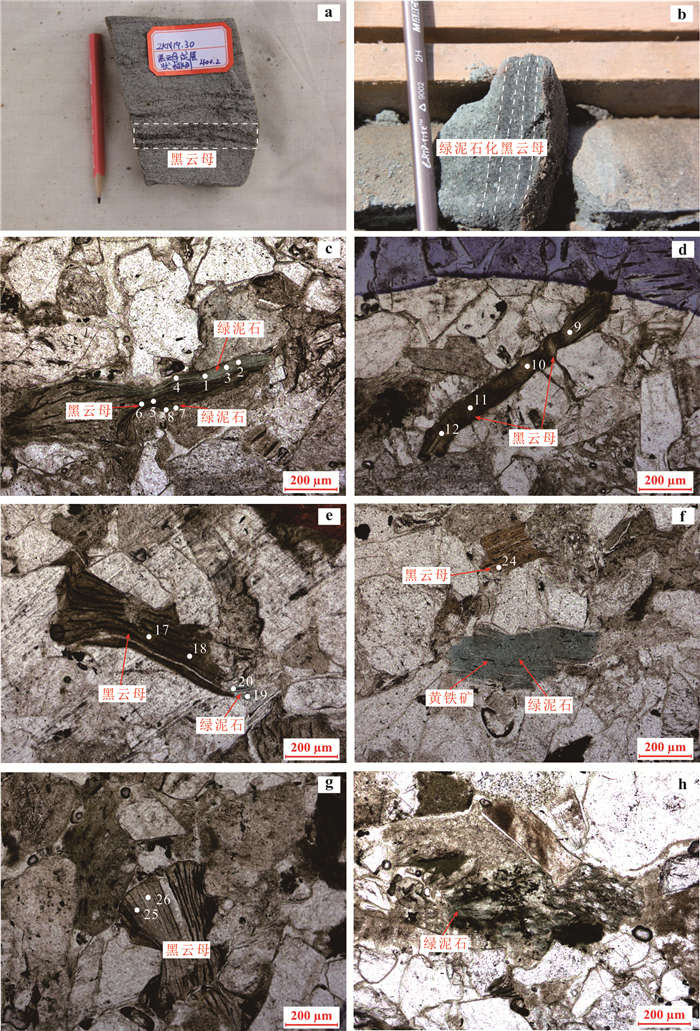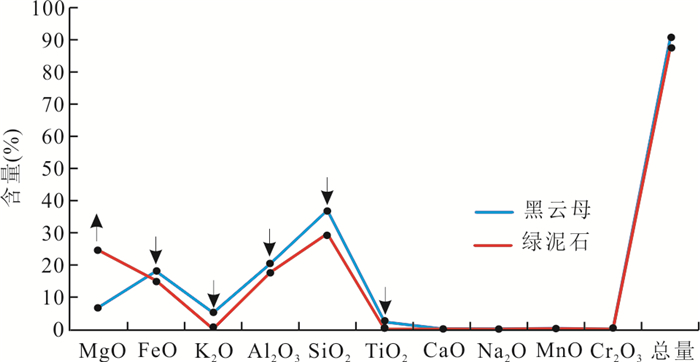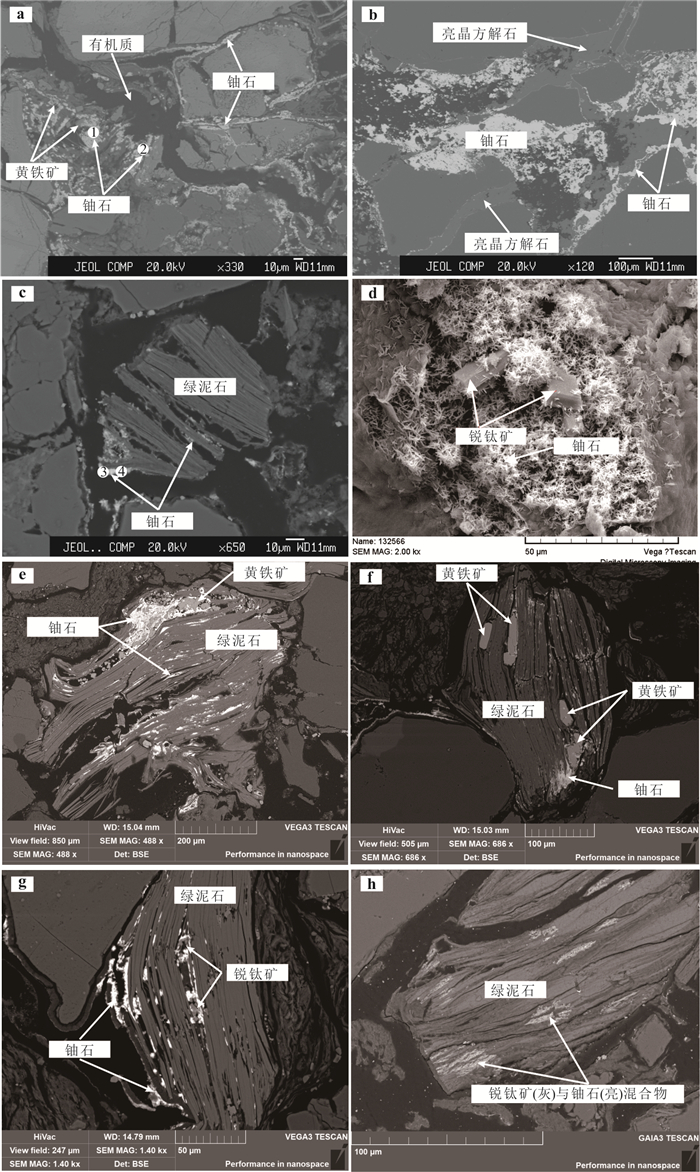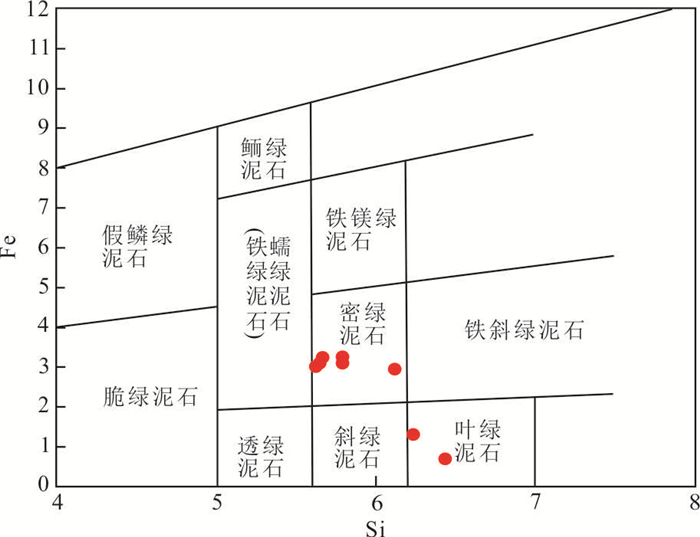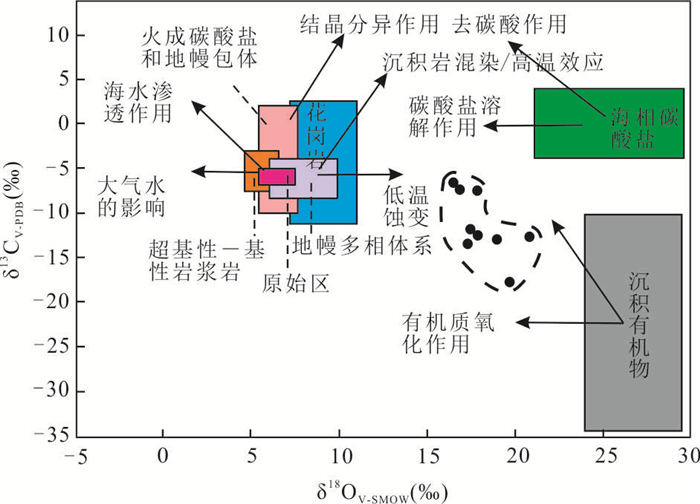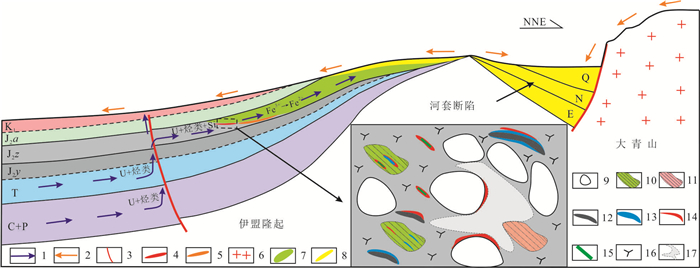Uranium Metallogenic Effect of Hydrothermal Fluid Transformation in Sandstone-Type Uranium Deposits in Northern Ordos Basin: Constraints from the Study of Biotite Chloritization Process
-
摘要: 鄂尔多斯盆地北缘铀矿集区是中国北方最重要的砂岩型铀矿产地之一,为查明该区砂岩型铀矿中热液改造的铀成矿效应,综合应用薄片鉴定、扫描电镜与电子探针等手段对黑云母绿泥石化过程的矿物-地球化学特征开展研究. 研究表明,鄂尔多斯盆地北缘砂岩型铀矿含矿层砂岩中黑云母多发生绿泥石化,常沿黑云母的解理和边缘进行蚀变交代,并伴随着Si,Fe,Ti,U等元素释放;与黑云母绿泥石化有关热液温度在137.3~208.3 ℃之间,为偏碱性-还原性质的中-低温含烃盆地热卤水. 鄂尔多斯盆地深部广泛发育富铀烃源岩,在持续埋藏与热事件作用下排烃与迁出的铀可随盆地热卤水沿断裂等通道运移,理论上可为该区砂岩型铀矿提供深部铀源. 当其运移至含矿层发生侧向迁移时,通过萃取砂岩中分散吸附铀和溶蚀早期形成铀矿物,造成铀的重新活化,并以有机络合物或有机胶体等形式迁移. 伴随着黑云母绿泥石化,形成绿泥石化黑云母-铀石、绿泥石化黑云母-黄铁矿-铀石、绿泥石化黑云母-锐钛矿-铀石、锐钛矿-铀石等热液蚀变矿物组合,为砂岩型铀矿中热液参与铀成矿提供了直接矿物学证据;在还原性容量、温度、压力与酸碱度的变化部位,以铀石的形式沉淀于黄铁矿、有机质与亮晶方解石周边,造成铀的进一步富集成矿,为砂岩型铀矿中热液改造的铀成矿效应提供了依据.Abstract: Uranium (U)-concentrated areaof northern Ordos Basin is one of the most important sandstone-type U deposits in north China. In order to find out the Umetallogenic effect of hydrothermal fluid transformation in this area, the mineral-geochemical characteristics of biotite chloritization process were studied by thin section identification, scanning electron microscopy (SEM) and electron probe (EMPA). The results show that biotite in sandstone-type U deposits in north Ordos Basin mostly occurs chloritization, which is often altered and metasomatized along the cleavage and edge of biotite, accompanied by the release of Si, Fe, Ti, U and other elements. Hydrothermal fluid related to altered biotiteis basin brine with hydrocarbon and has the characteristics of alkaline–reducing and medium-low temperature (137.3~208.3 ℃). Moreover, U-rich source rocks were widely developed in the deep part of the Ordos Basin and the hydrocarbon expulsion and emigrated U can migrate along the faults and other channels with the geothermal brine in basin under the action of continuous burial and thermal events, which can theoretically provide deep U sources forsandstone-type U deposits in this area. When it migratedlaterally to ore-bearing layer, the U-rich hydrothermal fluid was formed by extracting U fromthe ore-bearing sandstones and dissolving the U minerals formed in the early stage. U is reactivated and migrated in the form of organic complexes or organic colloids in hydrothermal fluid and precipitated in the form of coffinite around pyrite, organic matter and calciteat the changing parts of reducing capacity, temperature, pressure and pH, resulting, which provides a basis for the Umetallogenic effect of hydrothermal fluid transformation in sandstone-type U deposits. In addition, the above fluid-rock reaction was easy to cause biotite chloritization, forminghydrothermal altered mineral assemblages, such aschloritized biotite-coffinite, chloritized biotite-pyrite-coffinite, chloritized biotite-anatase-coffinite, anatase-coffinite, which also provides direct evidence for the participation of hydrothermal fluid in sandstone type U deposits.
-
图 1 鄂尔多斯盆地北缘地质简图(据易超等,2018修改)
1. 第四系;2. 下白垩统;3. 中侏罗统安定组;4. 中侏罗统直罗组;5. 中侏罗统延安组;6. 上三叠统延长组;7. 中三叠统二马营组;8. 盆地边界;9. 构造边界;10. 河流;11. 断层;12. 研究区;13. 铀矿床
Fig. 1. Geological map of the northern Ordos Basin(modified from Yi et al., 2018)
图 6 鄂尔多斯盆地北缘砂岩型铀矿含矿砂岩中绿泥石分类图解
底图据Inoue(1995)
Fig. 6. Chlorite classification in ore-bearing sandstone of sandstone-type U deposits in northern Ordos Basin
图 7 鄂尔多斯盆地北缘砂岩型铀矿含矿砂岩中亮晶方解石包裹体均一温度-盐度的关系图
底图据Stephen(2005);数据来自张龙等(2015)
Fig. 7. Relationship between homogenization temperature and salinity of calcite inclusions in ore-bearing sandstone of sandstone-type U deposits in northern Ordos Basin
图 9 鄂尔多斯盆地北缘砂岩型铀矿热流体改造的铀成矿效应模式图
1. 碱性-还原的含烃盆地热卤水;2. 氧化的大气降水;3. 断裂;4. 与热液改造有关的铀矿体;5. 古层间氧化铀矿体;6. 蚀源区;7. 二次还原绿色砂岩;8. 潜水氧化黄色砂岩;9. 岩屑;10. 绿泥石化黑云母;11. 黑云母;12. 有机质;13. 胶状黄铁矿;14. 铀矿物;15. 锐钛矿;16. 杂基及黏土矿物;17. 亮晶方解石
Fig. 9. Umetallogenic effect model of hydrothermal fluid transformation in sandstone-type Udeposits in Northern Ordos Basin
表 1 鄂尔多斯盆地含矿层砂岩中黑云母与绿泥石电子探针分析结果(%)
Table 1. Analysis results of biotite and chlorite with electron probe in ore-bearing sandstone of sandstone-type U deposits in northern Ordos Basin
岩性 测试对象 测点 MgO FeO K2O Al2O3 SiO2 TiO2 CaO Na2O MnO UO2 Cr2O3 总量 Si AlⅣ AlⅥ Fe2+ Mg Al/(Fe+Mg+Al) t(℃) 灰绿色-绿色中-粗砂岩 黑云母 5 11.96 18.74 4.20 16.05 34.67 0.97 0.06 0.07 0.17 / 0.08 86.97 / / / / / / 黑云母 6 12.34 18.46 4.26 15.70 35.25 0.99 0.06 0.07 0.18 / / 87.31 / / / / / / 黑云母 9 3.38 24.83 9.77 18.77 33.62 2.57 / 0.09 0.61 / / 93.64 / / / / / / 黑云母 10 3.65 25.51 9.21 18.74 34.01 2.65 / 0.10 0.66 / / 94.53 / / / / / / 黑云母 11 3.62 24.63 9.63 18.53 34.33 3.06 / 0.19 0.65 / / 94.64 / / / / / / 黑云母 12 3.50 25.67 9.65 18.92 33.83 2.67 / 0.11 0.58 / 0.04 94.97 / / / / / / 黑云母 17 10.65 20.86 1.99 15.76 35.26 3.07 0.42 0.27 0.13 / / 88.41 / / / / / / 黑云母 18 9.37 21.35 0.44 16.86 34.12 2.99 0.67 0.20 0.20 / 0.06 86.26 / / / / / / 黑云母 24 14.99 13.68 6.40 14.15 36.38 5.79 / 0.15 / / 0.05 91.59 / / / / / / 黑云母 25 1.01 2.39 0.39 35.24 47.30 0.28 0.21 0.07 / / / 86.89 / / / / / / 黑云母 26 0.95 2.26 0.36 35.79 47.85 0.19 0.27 0.09 / / 0.05 87.81 / / / / / / 平均值 6.86 18.03 5.12 20.41 36.97 2.29 0.15 0.13 0.29 0.03 90.36 黑云母绿泥石化 1 21.44 19.15 0.02 19.29 27.96 / 0.03 0.02 0.27 0.08 0.05 88.31 5.66 2.34 2.26 3.24 6.47 0.32 207.8 黑云母绿泥石化 2 21.53 17.73 / 19.95 27.65 / 0.07 0.03 0.27 0.05 0.15 87.43 5.61 2.39 2.38 3.01 6.51 0.33 208.3 黑云母绿泥石化 3 21.85 17.99 / 19.03 27.83 / 0.02 0.03 0.20 / 0.09 87.04 5.68 2.32 2.25 3.07 6.65 0.32 205.0 黑云母绿泥石化 4 22.98 18.56 0.02 17.95 28.87 / 0.04 / 0.27 / / 88.69 5.80 2.21 2.04 3.11 6.87 0.30 198.7 黑云母绿泥石化 7 18.99 17.47 0.05 19.74 30.35 / 0.17 0.09 0.28 / / 87.14 6.11 1.89 2.79 2.94 5.70 0.35 178.7 黑云母绿泥石化 8 20.37 18.53 0.05 19.50 28.65 / 0.12 0.05 0.28 / / 87.55 5.81 2.19 2.47 3.14 6.16 0.33 198.1 黑云母绿泥石化 19 37.47 4.06 0.22 12.19 34.47 0.14 0.05 0.04 0.00 / / 88.64 6.43 1.57 1.10 0.63 10.41 0.20 137.3 黑云母绿泥石化 20 31.38 7.84 0.18 13.79 31.93 0.19 0.16 0.03 0.10 / 0.03 85.63 6.28 1.72 1.48 1.29 9.21 0.23 152.1 平均值 24.50 15.17 0.07 17.68 29.71 0.04 0.08 0.04 0.21 0.04 87.57 表 2 鄂尔多斯盆地含矿层砂岩中铀矿物电子探针分析结果(%)
Table 2. Analysis results of U minerals with electron probein ore-sandstone of sandstone-type U deposits in northern Ordos Basin
测点 Na2O SiO2 UO2 SO3 Al2O3 MgO CaO Fe2O3 Y2O3 PbO MnO K2O TiO2 ThO2 V2O3 P2O5 总量 1 0.10 17.86 70.64 0.04 0.93 / 1.25 0.09 0.6 / 0.08 / 0.19 / / 0.11 91.89 2 0.15 17.58 69.31 / 1.1 / 1.51 / 0.43 / 0.16 / 0.12 0.61 / 0.18 91.15 3 0.18 20.37 58.89 0.09 2.77 0.75 3.59 0.85 0.11 0.79 / 0.21 / / 0.14 0.79 89.53 4 0.37 20.87 61.57 / 2.64 0.58 4.08 0.47 0.11 0.59 / 0.26 / / 0.14 0.59 92.27 注:测试在核工业北京地质研究院测试中心完成,其中/含量表示低于检出限. -
Brooks, S. C., Fredrickson, J. K., Carroll, S. L., et al., 2003. Inhibition of Bacterial U(Ⅵ) Reduction by Calcium. Environmental Science & Technology, 37(9): 1850-1858. https://doi.org/10.1021/es0210042 Caritat, P., Hutchion, I., Walshe, J. L., 1993. Chlorite Geothermometry: A Review. Clays and Clay Minerals, 41(2): 219-239. https://doi.org/10.1346/ccmn.1993.0410210 Chen, L. L., Chen, Y., Feng, X. X., et al., 2019. Uranium Occurrence State in the Tarangaole Area of the Ordos Basin, China: Implications for Enrichment and Mineralization. Ore Geology Reviews, 115(4): 103034. https://doi.org/10.1016/j.oregeorev.2019.103034 Chen, Y., Li, J. G., Miao, P. S., et al., 2022. Relationship between the Tectono-Thermal Events and Sandstone-Type Uranium Mineralization in the Southwestern Ordos Basin, Northern China: Insights from Apatite and Zircon Fission Track Analyses. Ore Geology Reviews, 143(1): 104792. https://doi.org/10.1016/j.oregeorev.2022.104792 Christian, D., Dimosthenis, S., Thomas, K., et al., 2020. Calcium-Uranyl-Carbonato Species Kinetically Limit U(Ⅵ) Reduction by Fe(Ⅱ) and Lead to U(Ⅴ)-Bearing Ferrihydrite. Environmental Science & Technology, 54(10): 6021-6030. https://doi.org/10.1021/acs.est.9b05870. Deer, W. A., Howie, R. A., Zussman, J., 1962. Rock-Forming Minerals: Sheet Silicates. Longman, London, 528. Ding C., 2013. The Meso-Cenozoic Tectonic Events and Hydrocarbon Accumulation Effects on Dynamothermal Transition in Northeastern Ordos Basin (Dissertation). Northwest University, Xi'an (in Chinese with English abstract). Ding, B., Liu, H. X., Qiu, L. F., et al., 2022. Ilmenite Alteration and its Adsorption and Catalytic Reduction in U Enrichment in Sandstone-Hosted U Deposits from the Northern Ordos Basin, North China. Minerals, 12(2): 167. https://doi.org/10.3390/min12020167 Ding, B., Liu, H. X., Zhang, B., et al., 2020. The Formation Mechanism of Tabular Orebody of Sandstone-Type Uranium in Northern Ordos Basin: Constraints on the Study of Kaolinite Content from Different Zones of Ore-Bearing Sandstone. Acta Geologica Sinica, 94(10): 2874-2882(in Chinese with English abstract). English, K. L., English, J. M., Redfern, J., et al., 2016. Remobilization of Deep Basin Brine during Exhumation of the Illizi Basin, Algeria. Marine and Petroleum Geology, 78: 679-689. https://doi.org/10.1016/j.marpetgeo.2016.08.016 Foster, M. D., 1962. Interpretation of the Composition and Classification for the Chlorite. US Grology Survey Prof. Paper, 414A: 33. Fuchs, S., Schumann, D., Williams-Jones, A. E., et al., 2015. The Growth and Concentration of Uranium and Titanium Minerals in Hydrocarbons of the Carbon Leader Reef, Witwatersrand Supergroup, South Africa. Chemical Geology, 393-394: 55-66. https://doi.org/10.1016/j.chemgeo.2014.11.018 Hou, B. H., Keeling, J., Li, Z. Y., 2017. Paleovalley-Related Uranium Deposits in Australia and China: A Review of Geological and Exploration Models and Methods. Ore Geology Reviews, 88(2): 201-234. https://doi.org/10.1016/j.oregeorev.2017.05.005 Inoue, A., 1995. Potassium Fixation by Clay Minerals during Hydrothermal Treatment. Clays and Clay Minerals, 31(2): 81-91. https://doi.org/10.1346/ccmn.1983.0310201 Jiao, Y. Q., Wu, L. Q., Rong, H., et al., 2021. Review of Basin Uranium Resources in China. Earth Science, 46(8): 2675-2696 (in Chinese with English abstract). Li, Y. Q., 2018. Experiments of Oil or Gas-Uranium Relationship in the Hydrocarbon Generation Process of Deep Source Rocks in the Ordos Basin and Its Geological Significance (Dissertation). Northwest University, Xi'an(in Chinese with English abstract). Li, Z. Y., Fang, X. H., Chen, A. P., et al., 2007. Origin of Gray-Green Sandstone in Ore Bed of Sandstone Type Uranium Deposit in North Ordos Basin. Sci. China Ser. (D Earth Sci), 50(Suppl): 139-146 (in Chinese with English abstract). Lin, S. X., Gong, X. F., Zhang, T. L., 2017. Deep Geofluid and Uranium Metallogenesis in Meso-Cenozonic Basin. Uranium Geology, 33(6): 321-329 (in Chinese with English abstract). Liu, B., Peng, Y. B., Kang, S. H., et al., 2018. Depositional Characteristics and Uranium Metallogenic Fluid Dynamics of Uranium Bearing Paleo-Valley of the Saihan Formation in Basaiqi, Erlian Basin. Bulletin of Mineralogy, Petrology and Geochemistry, 37(2): 316-325 (in Chinese with English abstract). Liu, C. Y., Wang, J. Q., Zhang, D. D., et al., 2021. Genesis of Rich Hydrocarbon Resources and their Occurrence and Accumulation Characteristics in the Ordos Basin. Oil &Gas Geology, 42(5): 311-320 (in Chinese with English abstract). Liu, C. Y., Zhao, H. G., Gui, X. J., et al., 2006. Space-Time Coordinate of the Evolution and Reformation and Mineralization Response in Ordos Basin. Acta Geologica Sinica, 80(5): 617-638 (in Chinese with English abstract). Liu, J. M., Liu J. J., 1997. Basin Fluid Genetic Model of Sediment-Hosted Microdisseminated Gold Deposits in the Gold-Triangle Area between Guizhou, Guangxi and Yunnan. Acta Mineralogica Sinica, 17(4): 448-456 (in Chinese with English abstract). Liu, S., Zhang, C. Y., Nie, F. J., et al., 2017. Relationship of Fluid Transformation and Uranium Mineralization in Tamusu Area of Bayingobi, Inner Mongolia. Uranium Geology, 33(4) : 199-205 (in Chinese with English abstract). Liu, Y. P., Zhang, S. Y., Zhang H. F., 2016. Advances on Mineral Genesis of Chlorite: A Review. Advances in Geosciences, 6(3): 264-282 (in Chinese with English abstract). doi: 10.12677/AG.2016.63028 Luo, X. N., Zhang, Y. Y., Yi, C., et al., 2021. Characteristics of Chlorite and Their Relationship with Uranium Mineralization in the Bayinqinggeli Uranium Deposit of Ordos Basin. World Nuclear Geoscience, 38(3): 311-320 (in Chinese with English abstract). Nie, F. J., Lin, S. X., Yan, Z. B., et al., 2010. Hydrothermal Mineralization of Uranium in Sandstone, Teguida, Niger. Acta Geoscientica Sinica, 31(6): 819-831 (in Chinese with English abstract). Nie, F. J., Yan, Z. B., Xia. F., et al., 2017. Hot Fluid Flows in the Sandstone-Type Uranium Deposit in the Kailu Basin, Northeast China. Geological Bulletin of China, 36(10): 1850-1866 (in Chinese with English abstract). Nieto, F., 1997. Chemical Composition of Metapelitic Chlorites: X-Ray Diffraction and Optical Property Approach. Eur. J. Mineral. , 829-841. Pablo, J. D., Casas, I., Giménez, J., et al., 1999. The Oxidative Dissolution Mechanism of Uranium Dioxide. Ⅰ. the Effect of Temperature in Hydrogen Carbonate Medium. Geochimica et Cosmochimica Acta, 63(19/20): 3097-3103. https://doi.org/10.1016/s0016-7037(99)00237-9 Qin, M. K., Huang, S. H., Liu, J. L., et al., 2021. Hydrothermal Alteration and its Superimposed Enrichment for Qianjiadian Tabular-Type Uranium Deposit in Southwestern Songliao Basin. Minerals, 12(1): 52. https://doi.org/10.3390/min12010052 Qin, Y., Zhang, W. Z., Peng P. A., et al., 2009. Occurrence and Concentration of Uranium in the Hydrocarbon Source Rocks of Chang 7 Member of YanchangFormation, Ordos basin. Acta Petrologica Sinica, 25(10): 2469-2476 (in Chinese with English abstract). Rausell-Colom, J. A., Wiewiora, A., Matesanz, E., 1991. Relationship between Composition and d001 for Chlorite. American Mineralogist, 76(7/8): 1373-1379. Ren Z. L., Zhang, S., Gao, S. L., et al., 2006. Relationship between Thermal History and Various Energy Mineral Deposits inDongsheng Area, Yimeng Uplift. Oil & Gas Geology, 27(2): 187-193(in Chinese with English abstract). Stefano, H., 1978. Developments in Sedimentology (Chlorite Minerals). Elservier, New York, 243-246. Stephen, E. K., 2005. Ore-Forming Fluids. Elements; 1(1): 13-18. https://doi.org/10.2113/gselements.1.1.13 Tian, J. F., Chen, Z. L., Fan, Y. F., et al., 2008. The Occurrence, Growth Mechanism and Distribution of Authigenic Chlorite in Sandstone. Bulletin of Mineralogy, Petrology and Geochemistry, 27(2): 200-206 (in Chinese with English abstract). Wang, G., Wang, Q., Miao, A. S., et al., 2017. Characteristic of Uranium Minerals in Nalinggou Uranium Deposit of Ordos Basin and Their Formation Mechanism. Acta Mineralogica Sinaca, 37(4): 461-469 (in Chinese with English abstract). Wang, M., Wu, B. L., Li, Y. Q., et al., 2022. Experimental Study on Possibility of Deep Uranium-Rich Source Rocks Providing Uranium Source in Ordos Basin. Earth Science, 47(1): 224-239 (in Chinese with English abstract). Wu, B. L., Wei, A. J., Hu L., 2014. The Hydrocarbon Dissipation and Its Effect of Diagenetic and Mineralization: Progress, Understanding and Outlook. Geological Review, 60(6): 1199-1211 (in Chinese with English abstract). Wu, B. L., Zhang, W. Y., Song, Z. S., et al., 2016. Geological and Geochemical Characteristics of Uranium Minerals in the Sandstone-Type Uranium Deposits in the North of Ordos Basin and Their Genetic Significance. Acta Geological Sinica, 90(12): 3393-3407 (in Chinese with English abstract). Xia, F., Meng, H., Nie, F. J., et al., 2016. Characteristics of Chlorite from the Nalinggou Uranium Deposit in the Ordos Basin and Its Geological Significance. Acta Geological Sinica, 90(12): 3473-3482 (in Chinese with English abstract). Xiao, X. J., Li, Z. Y., Fang X. H., et al., 2004. The Evidences and Significances of Epithermal Mineralization Fluid in the Dongsheng Sandstone Type Uranium Deposit. Bulletin of Mineralogy, Petrology and Geochemistry, 23(4): 301-303 (in Chinese with English abstract). doi: 10.3969/j.issn.1007-2802.2004.04.004 Xie, H. L., Jiao, Y. Q., Liu, Z. Y., et al., 2020. Occurrence and Enrichment Mechanism of Uranium Ore Minerals fromSandstone-Type Uranium Deposit, Northern Ordos Basin. Earth Science, 45(5): 1531-1543(in Chinese with English abstract). Xue, C. J., Chi, G. X., Xue, W., 2010. Interaction of Two Fluid Systems in the Formation of Sandstone-Hosted Uranium Deposits in the Ordos Basin: Geochemical Evidence and Hydrodynamic Modeling. Journal of Geochemical Exploration, 106(1/2/3): 226-235. https://doi.org/10.1016/j.gexplo.2009.11.006 Yi, C., Wang, G., Li, X. D., et al., 2018. A Tentative Discussion on Uranium Enrichment Characteristics and Metallogenic Model in Zhiluo Formation, Northeastern Ordos Basin. Mineral Deposits, 37(4): 835-852 (in Chinese with English abstract). Zhang, C. Y., Nie, F. J., Jiao, Y. Q., et al., 2019a. Characterization of Ore-Forming Fluids in the Tamusu Sandstone-Type Uranium Deposit, Bayingobi Basin, China: Constraints from Trace Elements, Fluid Inclusions and C-O-S Isotopes. Ore Geology Reviews, 111: 102999. https://doi.org/10.1016/j.oregeorev.2019.102999 Zhang, G. X., Miao, A. S., Li, W. H., et al., 2016. The Role of Boerjianghaizi Faults in Sandstone-Type Uranium Mineralization. Journal of East China University of Technology (Natural Science), 39(1): 15-22 (in Chinese with English abstract). Zhang, J. D., 2016. Innovation and Development of Metallogenic Theory for Sandstone Type Uranium Deposit in China. Uranium Geology, 32(6): 321-332 (in Chinese with English abstract). Zhang, L., Liu, C. Y., Lei, K. Y., 2019b. Green Altered Sandstone Related to Hydrocarbon Migration from the Uranium Deposits in the Northern Ordos Basin, China. Ore Geology Reviews, 109: 482-493. https://doi.org/10.1016/j.oregeorev.2019.05.008 Zhang, L., Liu, C. Y., Zhao, Z. P., et al., 2015. Fluid Evolution and Mineralization of Hangjinqi Sandstone-Type Uranium Deposit, Ordos Basin. Earth Science Frontiers, 22(3): 368-381 (in Chinese with English abstract). Zhang, S. Z., Hua, R. M., Ji, J. f., et al., 2007. Characteristics and Formation Conditions of Chlorite in No. 201 and No. 361 Uranium Deposits. Acta Mineralogical Sinica, 27(2): 161-172 (in Chinese with English abstract). Zhang, Z. L., Han, X. Z., Li, S. X., et al., 2010. Sedimentary Facies of the Lower Part of Middle Jurassic Zhiluo Formation in Northeastern Ordos Basin and Its Controls on Uranium Mineralization. Journal of Palaeogeography, 12(6): 749-758. Zhou, H. P., Zhang, K., Li, G., 2008. Cretaceous Tectono-Thermal Eventin the Ordos Block: An Ar-Ar Chronological Evidence from Basaltat Hangjinqi Banner, Inner Mongolia, North China Craton. Geotectonica et Metallogenia, 32(3): 360-364(in Chinese with English abstract). 丁波, 刘红旭, 张宾, 等, 2020. 鄂尔多斯盆地北缘砂岩型铀矿板状矿体形成机制: 来自含矿层不同分带砂岩中高岭石含量研究的约束. 地质学报, 94(10): 2874-2882. https://www.cnki.com.cn/Article/CJFDTOTAL-DZXE202010007.htm 丁超, 2013. 鄂尔多斯盆地东北部中新生代构造事件及其动热转换的油气成藏效应(博士学位论文). 西安: 西北大学. 焦养泉, 吴立群, 荣辉, 等, 2021. 中国盆地铀资源概述. 地球科学, 46(8): 2675-2696. doi: 10.3799/dqkx.2020.304 李艳青, 2018. 鄂尔多斯盆地深部烃源岩生烃过程的油或气-铀关系实验及地质意义(硕士学位论文). 西安: 西北大学. 李子颖, 方锡珩, 陈安平, 等, 2007. 鄂尔多斯盆地北部砂岩型铀矿目标层灰绿色砂岩成因. 中国科学(D辑: 地球科学), 2007, 37(增刊): 139-146. https://www.cnki.com.cn/Article/CJFDTOTAL-JDXK2007S1015.htm 林双幸, 宫晓峰, 张铁岭, 2017. 中新生代盆地深部地质流体及铀成矿作用. 铀矿地质, 33(6): 321-329. https://www.cnki.com.cn/Article/CJFDTOTAL-YKDZ201706001.htm 刘波, 彭云彪, 康世虎, 等, 2018. 二连盆地巴赛齐赛汉组含铀古河谷沉积特征及铀成矿流体动力学. 矿物岩石地球化学通报, 37(2): 316-325. https://www.cnki.com.cn/Article/CJFDTOTAL-KYDH201802016.htm 刘池洋, 王建强, 张东东, 等, 2021. 尔多斯盆地油气资源丰富的成因与赋存-成藏特点. 石油与天然气地质, 42(5): 311-320. 刘建明, 刘家军, 1997. 滇黔桂金三角区微细浸染型金矿床的盆地流体成因模式. 矿物学报, 17(4): 448-456. doi: 10.3321/j.issn:1000-4734.1997.04.012 刘帅, 张成勇, 聂逢君, 等, 2017. 巴音戈壁盆地塔木素地区流体改造与铀成矿. 铀矿地质, 33(4): 199-196. https://www.cnki.com.cn/Article/CJFDTOTAL-YKDZ201704002.htm 刘焱平, 张少颖, 张华锋, 2016. 绿泥石的成因矿物学研究综述. 地球科学前沿, 6(3): 264-282. 骆效能, 张玉燕, 易超, 等, 2021. 鄂尔多斯盆地巴音青格利铀矿床绿泥石特征及其与铀成矿的关系. 世界核地质科学, 38(3): 311-320. https://www.cnki.com.cn/Article/CJFDTOTAL-GWYD202103003.htm 聂逢君, 林双幸, 严兆彬, 等, 2010. 尼日尔特吉达地区砂岩中铀的热液成矿作用. 地球学报, 31(6): 819-831. https://www.cnki.com.cn/Article/CJFDTOTAL-DQXB201006010.htm 聂逢君, 严兆彬, 夏菲, 等, 2017. 内蒙古开鲁盆地砂岩型铀矿热液作用. 地质通报, 36(10): 1850-1866. https://www.cnki.com.cn/Article/CJFDTOTAL-ZQYD201710016.htm 秦艳, 张文正, 彭平安, 等, 2009. 鄂尔多斯盆地延长组长7段富铀烃源岩的铀赋存状态与富集机理. 岩石学报, 25(10): 2469-2476. https://www.cnki.com.cn/Article/CJFDTOTAL-YSXB200910015.htm 任战利, 张盛, 高胜利, 等, 2006. 伊盟隆起东胜地区热演化史与多种能源矿产的关系. 石油与天然气地质, 27(2): 187-193. https://www.cnki.com.cn/Article/CJFDTOTAL-SYYT200602008.htm 田建锋, 陈振林, 凡元芳, 等, 2008. 砂岩中自生绿泥石的产状、形成机制及其分布规律. 矿物岩石地球化学通报, 27(2): 200-206. https://www.cnki.com.cn/Article/CJFDTOTAL-KYDH200802017.htm 王贵, 王强, 苗爱生, 等, 2017. 鄂尔多斯盆地纳岭沟铀矿床铀矿物特征与形成机理. 矿物学报, 37(4): 461-469. https://www.cnki.com.cn/Article/CJFDTOTAL-KWXB201704013.htm 王苗, 吴柏林, 李艳青, 等, 2022. 鄂尔多斯盆地深部富铀烃源岩提供铀源可能性的实验研究. 地球科学, 47(1): 224-239. doi: 10.3799/dqkx.2021.050 吴柏林, 魏安军, 胡亮, 等, 2014. 油气耗散作用及其成岩成矿效应: 进展、认识与展望. 地质论评, 60(6): 1199-1211. https://www.cnki.com.cn/Article/CJFDTOTAL-DZLP201406002.htm 吴柏林, 张婉莹, 宋子升, 等, 2016. 鄂尔多斯盆地北部砂岩型铀矿铀矿物地质地球化学特征及其成因意义. 地质学报, 90(12): 3393-3407. https://www.cnki.com.cn/Article/CJFDTOTAL-DZXE201612009.htm 夏菲, 孟华, 聂逢君, 等, 2016. 鄂尔多斯盆地纳岭沟铀矿床绿泥石特征及地质意义. 地质学报, 90(12): 3473-3482. doi: 10.3969/j.issn.0001-5717.2016.12.014 肖新建, 李子颖, 方锡珩, 等, 2004. 东胜砂岩型铀矿床低温热液流体的证据及意义. 矿物岩石地球化学通报, 23(4): 301-304. doi: 10.3969/j.issn.1007-2802.2004.04.004 谢惠丽, 焦养泉, 刘章月, 等, 2020. 鄂尔多斯盆地北部铀矿床铀矿物赋存状态及富集机理. 地球科学, 45(5): 1531-1543. doi: 10.3799/dqkx.2019.164 易超, 王贵, 李西得, 等, 2018. 鄂尔多斯盆地东北部直罗组铀富集特征及铀成矿模式探讨. 矿床地质, 37(4): 835-852. https://www.cnki.com.cn/Article/CJFDTOTAL-KCDZ201804008.htm 张更信, 苗爱生, 李文辉, 等, 2016. 泊尔江海子断裂带在砂岩型铀矿成矿中的作用. 东华理工大学学报: 自然科学版, 39(1): 15-22. https://www.cnki.com.cn/Article/CJFDTOTAL-HDDZ201601003.htm 张金带, 2016. 我国砂岩型铀矿成矿理论的创新和发展. 铀矿地质, 32(6): 321-332. doi: 10.3969/j.issn.1000-0658.2016.06.001 张龙, 刘池洋, 赵中平, 等, 2015. 鄂尔多斯盆地杭锦旗地区砂岩型铀矿流体作用与成矿. 地学前缘, 22(3): 368-381. https://www.cnki.com.cn/Article/CJFDTOTAL-DXQY201503035.htm 张展适, 华仁民, 季俊峰, 等, 2007. 201和361铀矿床中绿泥石的特征及其形成环境研究. 矿物学报, 27(2): 161-172. https://www.cnki.com.cn/Article/CJFDTOTAL-KWXB200702010.htm 张字龙, 韩效忠, 李胜祥, 等, 2010. 鄂尔多斯盆地东北部中侏罗统直罗组下段沉积相及其对铀成矿的控制作用. 古地理学报, 12(6): 749-758. https://www.cnki.com.cn/Article/CJFDTOTAL-GDLX201006014.htm 邹和平, 张珂, 李刚, 2008. 鄂尔多斯地块早白垩世构造-热事件: 杭锦旗玄武岩的Ar-Ar年代学证据. 大地构造与成矿学, 32(3): 360-364. https://www.cnki.com.cn/Article/CJFDTOTAL-DGYK200803015.htm -










 下载:
下载:

